fuel cap MITSUBISHI OUTLANDER 2018 Owner's Manual (in English)
[x] Cancel search | Manufacturer: MITSUBISHI, Model Year: 2018, Model line: OUTLANDER, Model: MITSUBISHI OUTLANDER 2018Pages: 441, PDF Size: 13.71 MB
Page 25 of 441
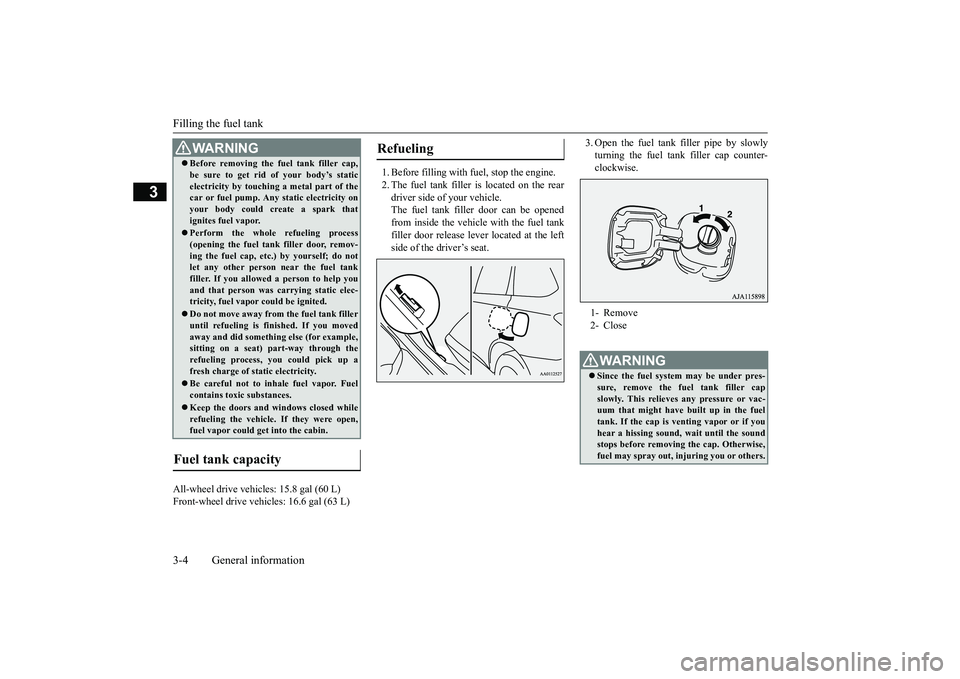
Filling the fuel tank3-4 General information
3
All-wheel drive vehicles: 15.8 gal (60 L)Front-wheel drive vehi
cles: 16.6 gal (63 L)
1. Before filling with fuel, stop the engine.2. The fuel tank filler is located on the reardriver side of your vehicle.The fuel tank filler door can be openedfrom inside the vehicle with the fuel tankfiller door release lever located at the leftside of the driver’s seat.
3. Open the fuel tank filler pipe by slowlyturning the fuel tank filler cap counter-clockwise.
Before removing the fuel tank filler cap,be sure to get rid of your body’s staticelectricity by touching a metal part of thecar or fuel pump. Any
static electricity on
your body could create a spark thatignites fuel vapor.Perform the whole
refueling process
(opening the fuel tank filler door, remov-ing the fuel cap, etc.) by yourself; do notlet any other
person near the fuel tank
filler. If you allowed
a person to help you
and that person was ca
rrying static elec-
tricity, fuel vapor could be ignited.Do not move away from
the fuel tank filler
until refueling is fi
nished. If you moved
away and did somethin
g else (for example,
sitting on a seat) part-way through therefueling process, you could pick up afresh charge of st
atic electricity.
Be careful not to inhale fuel vapor. Fuelcontains toxic substances.Keep the doors and wi
ndows closed while
refueling the vehicle. If they were open,fuel vapor could ge
t into the cabin.
Fuel tank capacity
WA R N I N G
Refueling
1- Remove2- CloseWA R N I N GSince the fuel system may be under pres-sure, remove the fuel tank filler capslowly. This relieves
any pressure or vac-
uum that might have built up in the fueltank. If the cap is venting vapor or if youhear a hissing sound, wait until the soundstops before removing the cap. Otherwise,fuel may spray out, in
juring you or others.
BK0249100US.book 4 ページ 2017年5月10日 水曜日 午前8時49分
Page 26 of 441
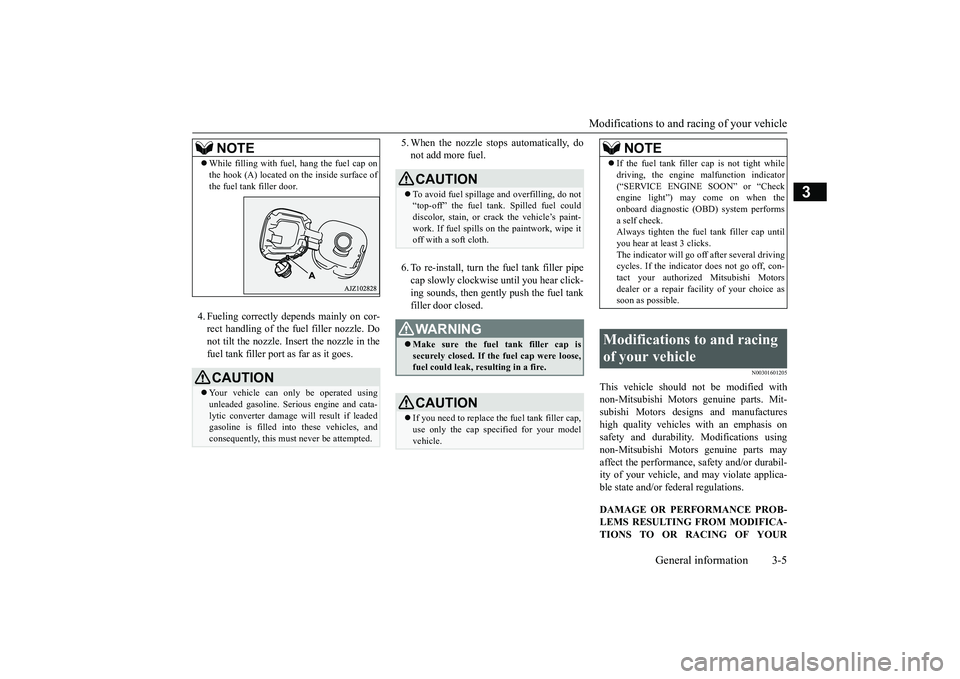
Modifications to and racing of your vehicle
General information 3-5
3
4. Fueling correctly depends mainly on cor-rect handling of the fuel filler nozzle. Donot tilt the nozzle. Insert the nozzle in thefuel tank filler port as far as it goes.
5. When the nozzle stops automatically, donot add more fuel.6. To re-install, turn the fuel tank filler pipecap slowly clockwise until you hear click-ing sounds, then gently push the fuel tankfiller door closed.
N00301601205
This vehicle should not be modified withnon-Mitsubishi Motors
genuine parts. Mit-
subishi Motors desi
gns and manufactures
high quality vehicles
with an emphasis on
safety and durability.
Modifications using
non-Mitsubishi Motors genuine parts mayaffect the performance,
safety and/or durabil-
ity of your vehicle, a
nd may violate applica-
ble state and/or fe
deral regulations.
DAMAGE OR PERFORMANCE PROB-LEMS RESULTING FROM MODIFICA-TIONS TO OR RACING OF YOUR
NOTE
While filling with fuel, hang the fuel cap onthe hook (A) located on the inside surface ofthe fuel tank filler door.CAUTIONYour vehicle can only be operated usingunleaded gasoline. Seri
ous engine and cata-
lytic converter damage will result if leadedgasoline is filled into these vehicles, andconsequently, this must
never be attempted.
CAUTIONTo avoid fuel spillage and overfilling, do not“top-off” the fuel tank.
Spilled fuel could
discolor, stain, or crack the vehicle’s paint-work. If fuel spills on the paintwork, wipe itoff with a soft cloth.WA R N I N GMake sure the fuel tank filler cap issecurely closed. If the fuel cap were loose,fuel could leak, re
sulting in a fire.
CAUTIONIf you need to replace th
e fuel tank filler cap,
use only the cap specified for your modelvehicle.
NOTE
If the fuel tank filler
cap is not tight while
driving, the engine malfunction indicator(
Page 84 of 441
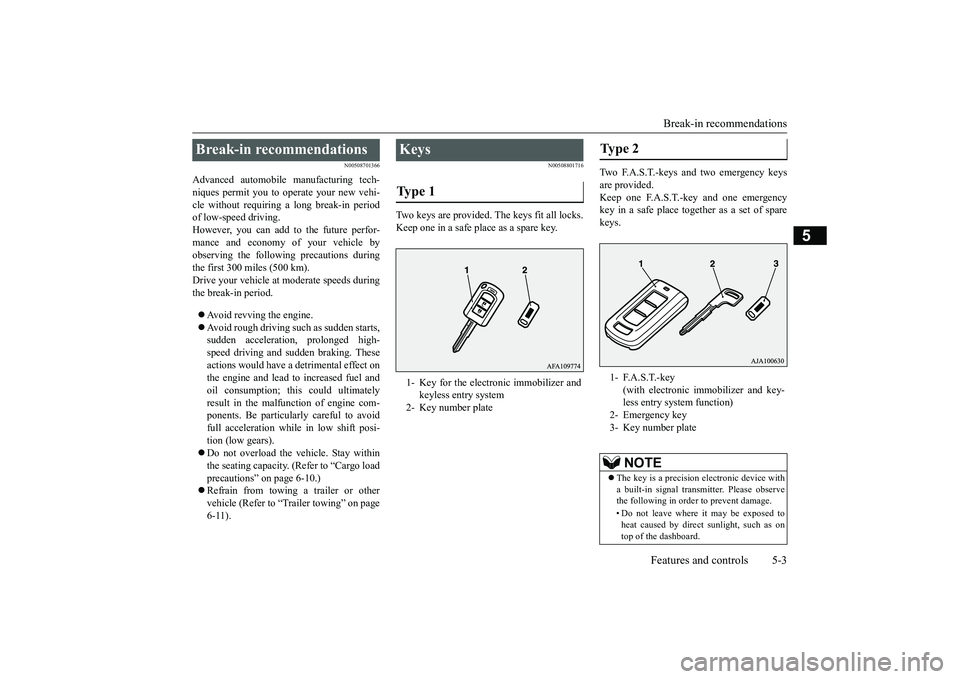
Break-in recommendations
Features and controls 5-3
5
N00508701366
Advanced automobile
manufacturing tech-
niques permit you to operate your new vehi-cle without requiring a long break-in periodof low-speed driving.However, you can add to the future perfor-mance and economy of your vehicle byobserving the following precautions duringthe first 300 miles (500 km).Drive your vehicle at m
oderate speeds during
the break-in period.Avoid revving the engine.Avoid rough driving such as sudden starts,sudden accelerati
on, prolonged high-
speed driving and sudden braking. Theseactions would have a detrimental effect onthe engine and lead to increased fuel andoil consumption; th
is could ultimately
result in the malfunction of engine com-ponents. Be particularly careful to avoidfull acceleration while in low shift posi-tion (low gears).Do not overload the vehicle. Stay withinthe seating capacity. (Refer to “Cargo loadprecautions” on page 6-10.)Refrain from towing a trailer or othervehicle (Refer to “T
railer towing” on page
6-11).
N00508801716
Two keys are provided. The keys fit all locks.Keep one in a safe place as a spare key.
Two F.A.S.T.-keys and two emergency keysare provided.Keep one F.A.S.T.-key and one emergencykey in a safe pl
ace together as a set of spare
keys.
Break-in recommendations
Keys Ty p e 1 1- Key for the electronic immobilizer and
keyless entry system
2- Key number plate
Type 2 1- F.A.S.T.-key
(with electronic im
mobilizer and key-
less entry system function)
3- Key number plate
NOTE
The key is a precision
electronic device with
a built-in signal transm
itter. Please observe
the following in order to prevent damage.• Do not leave where it may be exposed toheat caused by direct
sunlight, such as on
top of the dashboard.
BK0249100US.book 3 ページ 2017年5月10日 水曜日 午前8時49分
Page 285 of 441
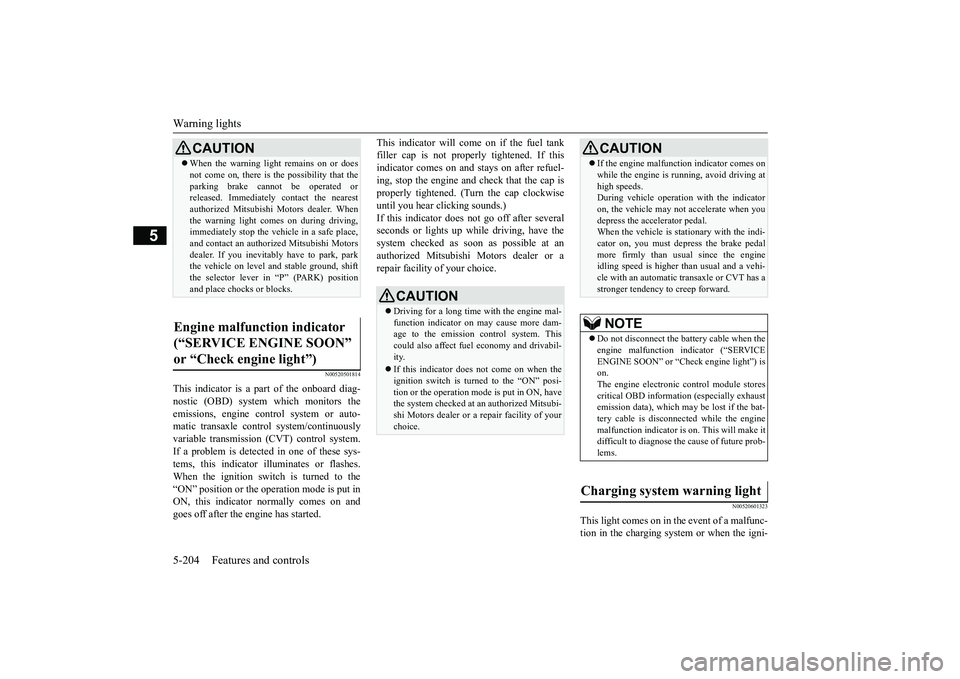
Warning lights5-204 Features and controls
5
N00520501814
This indicator is a pa
rt of the onboard diag-
nostic (OBD) system which monitors theemissions, engine control system or auto-matic transaxle control system/continuouslyvariable transmission (CVT) control system.If a problem is detected in one of these sys-tems, this indicator illuminates or flashes.When the ignition switch is turned to the“ON” position or the ope
ration mode is put in
ON, this indicator
normally comes on and
goes off after the engine has started.
This indicator will come on if the fuel tankfiller cap is not properly tightened. If thisindicator comes on and stays on after refuel-ing, stop the engine and check that the cap isproperly tightened. (Turn the cap clockwiseuntil you hear clicking sounds.)If this indicator does not go off after severalseconds or lights up while driving, have thesystem checked as soon as possible at anauthorized Mitsubishi Motors dealer or arepair facility of your choice.
N00520601323
This light comes on in the event of a malfunc-tion in the charging system or when the igni-
CAUTIONWhen the warning light remains on or doesnot come on, there is the possibility that theparking brake cannot
be operated or
released. Immediately contact the nearestauthorized Mitsubishi
Motors dealer. When
the warning light comes on during driving,immediately stop the vehi
cle in a safe place,
and contact an authorized Mitsubishi Motorsdealer. If you inevitably have to park, parkthe vehicle on level a
nd stable ground, shift
the selector lever in “P” (PARK) positionand place chocks
or blocks.
Engine malfunction indicator (“SERVICE ENGINE SOON” or “Check engine light”)
CAUTIONDriving for a long time
with the engine mal-
function indicator on may cause more dam-age to the emission control system. Thiscould also affect fuel
economy and drivabil-
ity.If this indicator does not come on when theignition switch is turned to the “ON” posi-tion or the operation mode is put in ON, havethe system checked at an authorized Mitsubi-shi Motors dealer or a repair facility of yourchoice.
If the engine malfuncti
on indicator comes on
while the engine is running, avoid driving athigh speeds.During vehicle operation
with the indicator
on, the vehicle may not
accelerate when you
depress the accelerator pedal.When the vehicle is stat
ionary with the indi-
cator on, you must depress the brake pedalmore firmly than usual since the engineidling speed is higher than usual and a vehi-cle with an automatic transaxle or CVT has astronger tendency to creep forward.NOTE
Do not disconnect the ba
ttery cable when the
engine malfunction i
ndicator (“SERVICE
ENGINE SOON” or “Ch
eck engine light”) is
on.The engine electronic
control module stores
critical OBD informati
on (especially exhaust
emission data), which ma
y be lost if the bat-
tery cable is disconne
cted while the engine
malfunction indicator is
on. This will make it
difficult to diagnose th
e cause of future prob-
lems.
Charging system warning light
CAUTION
BK0249100US.book 204 ページ 2017年5月10日 水曜日 午前8時49分
Page 331 of 441
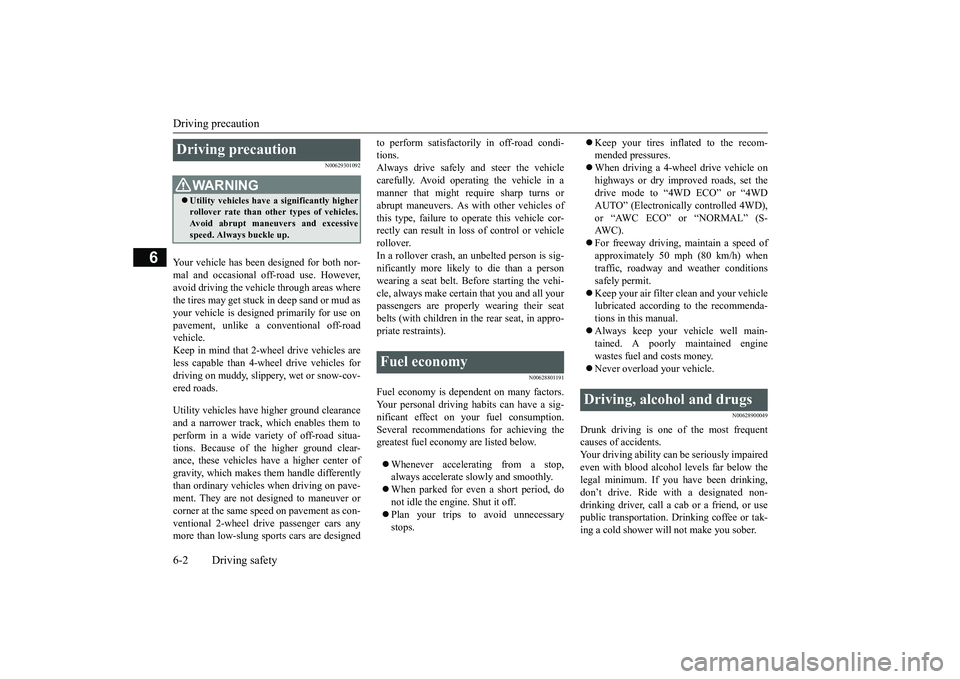
Driving precaution6-2 Driving safety
6
N00629301092
Your vehicle has been designed for both nor-mal and occasional off-road use. However,avoid driving the vehicle through areas wherethe tires may get stuck in deep sand or mud asyour vehicle is designe
d primarily for use on
pavement, unlike a conventional off-roadvehicle.Keep in mind that 2-wheel drive vehicles areless capable than 4-wh
eel drive vehicles for
driving on muddy, slippery, wet or snow-cov-ered roads.Utility vehicles have
higher ground clearance
and a narrower track, which enables them toperform in a wide variety of off-road situa-tions. Because of the higher ground clear-ance, these vehicles have a higher center ofgravity, which makes them handle differentlythan ordinary vehicles when driving on pave-ment. They are not designed to maneuver orcorner at the same speed on pavement as con-ventional 2-wheel driv
e passenger cars any
more than low-slung sports cars are designed
to perform satisfactorily in off-road condi-tions.Always drive safely
and steer the vehicle
carefully. Avoid operating the vehicle in amanner that might require sharp turns orabrupt maneuvers. As wi
th other vehicles of
this type, failure to operate this vehicle cor-rectly can result in lo
ss of control or vehicle
rollover.In a rollover crash, an unbelted person is sig-nificantly more likely to die than a personwearing a seat belt. Be
fore starting the vehi-
cle, always make cert
ain that you and all your
passengers are properly wearing their seatbelts (with children in the rear seat, in appro-priate restraints).
N00628801191
Fuel economy is depe
ndent on many factors.
Your personal driving habits can have a sig-nificant effect on your fuel consumption.Several recommendations
for achieving the
greatest fuel economy are listed below.Whenever accelerating from a stop,always accelerate
slowly and smoothly.
When parked for even a short period, donot idle the engine. Shut it off.Plan your trips to avoid unnecessarystops.
Keep your tires inflated to the recom-mended pressures.When driving a 4-wheel drive vehicle onhighways or dry improved roads, set thedrive mode to “4WD ECO” or “4WDAUTO” (Electronically controlled 4WD),or “AWC ECO” or “NORMAL” (S-AW C ) .For freeway driving, maintain a speed ofapproximately 50 mph (80 km/h) whentraffic, roadway and weather conditionssafely permit.Keep your air filter clean and your vehiclelubricated according
to the recommenda-
tions in this manual.Always keep your ve
hicle well main-
tained. A poorly maintained enginewastes fuel and costs money.Never overload your vehicle.
N00628900049
Drunk driving is one of the most frequentcauses of accidents.Your driving ability ca
n be seriously impaired
even with blood alcohol levels far below thelegal minimum. If you
have been drinking,
don’t drive. Ride with a designated non-drinking driver, call a cab or a friend, or usepublic transportation. Drinking coffee or tak-ing a cold shower will not make you sober.
Driving precaution
WA R N I N GUtility vehicles have
a significantly higher
rollover rate than othe
r types of vehicles.
Avoid abrupt maneuvers and excessivespeed. Always buckle up.
Fuel economy
Driving, alcohol and drugs
BK0249100US.book 2 ページ 2017年5月10日 水曜日 午前8時49分
Page 334 of 441
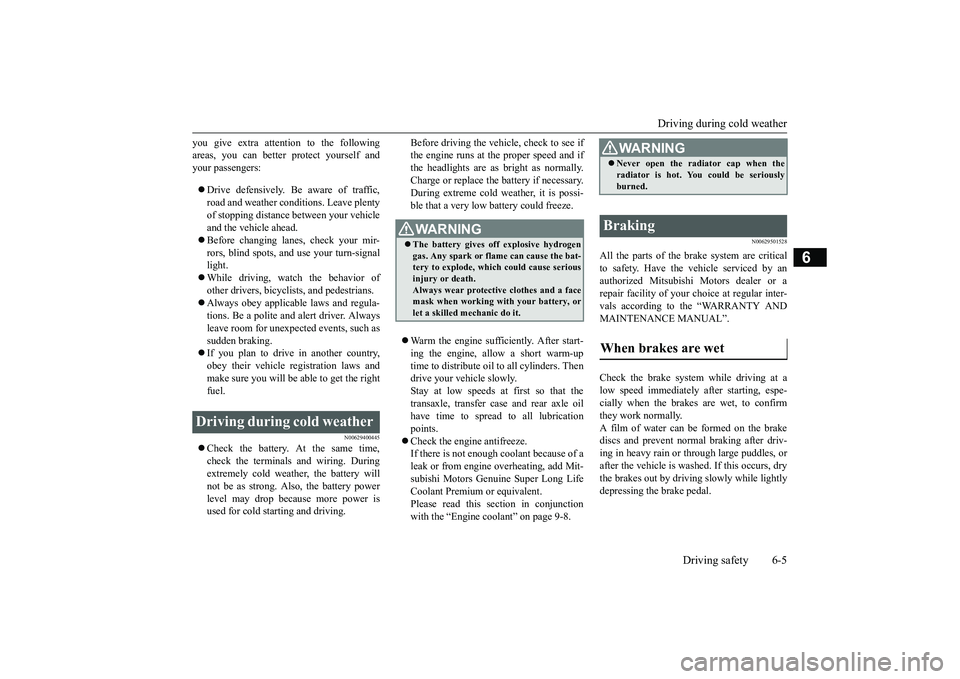
Driving during cold weather
Driving safety 6-5
6
you give extra attention to the followingareas, you can better protect yourself andyour passengers:Drive defensively. Be aware of traffic,road and weather c
onditions. Leave plenty
of stopping distance
between your vehicle
and the vehicle ahead.Before changing lanes, check your mir-rors, blind spots, a
nd use your turn-signal
light.While driving, watch the behavior ofother drivers, bicycl
ists, and pedestrians.
Always obey applicab
le laws and regula-
tions. Be a polite and alert driver. Alwaysleave room for unexpected events, such assudden braking.If you plan to drive in another country,obey their vehicle re
gistration laws and
make sure you will be able to get the rightfuel.
N00629400445
Check the battery. At the same time,check the terminals and wiring. Duringextremely cold weather, the battery willnot be as strong. Also, the battery powerlevel may drop beca
use more power is
used for cold starting and driving.
Before driving the vehicle, check to see ifthe engine runs at the proper speed and ifthe headlights are as bright as normally.Charge or replace the battery if necessary.During extreme cold weather, it is possi-ble that a very low battery could freeze.Warm the engine sufficiently. After start-ing the engine, allow a short warm-uptime to distribute oil to all cylinders. Thendrive your vehicle slowly.Stay at low speeds at first so that thetransaxle, transfer case and rear axle oilhave time to spread to all lubricationpoints.Check the engine antifreeze.If there is not enough coolant because of aleak or from engine
overheating, add Mit-
subishi Motors Genuine Super Long LifeCoolant Premium or equivalent.Please read this section in conjunctionwith the “Engine coolant” on page 9-8.
N00629501528
All the parts of the brake system are criticalto safety. Have the
vehicle serviced by an
authorized Mitsubishi Motors dealer or arepair facility of your
choice at regular inter-
vals according to the “WARRANTY ANDMAINTENANCE MANUAL”.Check the brake system while driving at alow speed immediately
after starting, espe-
cially when the brakes are wet, to confirmthey work normally.A film of water can be formed on the brakediscs and prevent normal braking after driv-ing in heavy rain or through large puddles, orafter the vehicle is washed. If this occurs, drythe brakes out by drivi
ng slowly while lightly
depressing the brake pedal.
Driving during cold weather
WA R N I N GThe battery gives off explosive hydrogengas. Any spark or flame can cause the bat-tery to explode, which could cause seriousinjury or death.Always wear protecti
ve clothes and a face
mask when working with your battery, orlet a skilled mechanic do it.
WA R N I N GNever open the radiator cap when theradiator is hot. You could be seriouslyburned.
Braking When brakes are wet
BK0249100US.book 5 ページ 2017年5月10日 水曜日 午前8時49分
Page 336 of 441
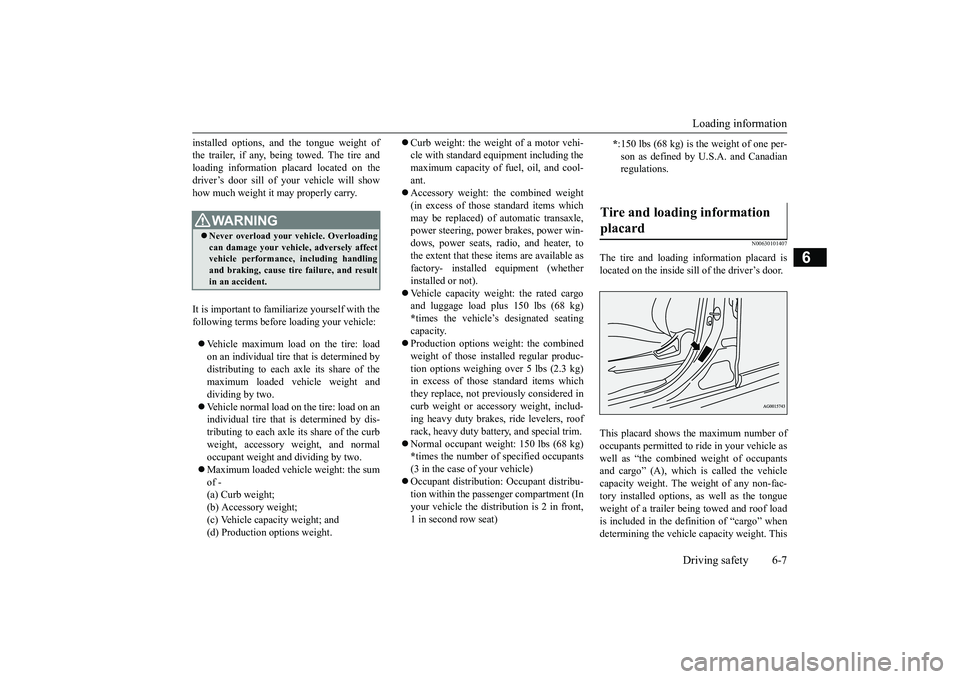
Loading informationDriving safety 6-7
6
installed options, and
the tongue weight of
the trailer, if any, being towed. The tire andloading information placard located on thedriver’s door sill of your vehicle will showhow much weight it may properly carry.It is important to famil
iarize yourself with the
following terms before loading your vehicle:Vehicle maximum load on the tire: loadon an individual tire that is determined bydistributing to each axle its share of themaximum loaded vehicle weight anddividing by two.Vehicle normal load on the tire: load on anindividual tire that is determined by dis-tributing to each axle its share of the curbweight, accessory weight, and normaloccupant weight and dividing by two.Maximum loaded vehicle weight: the sumof -(a) Curb weight;(b) Accessory weight;(c) Vehicle capacity weight; and(d) Production options weight.
Curb weight: the weight of a motor vehi-cle with standard equipment including themaximum capacity of
fuel, oil, and cool-
ant.Accessory weight: the combined weight(in excess of those st
andard items which
may be replaced) of automatic transaxle,power steering, power brakes, power win-dows, power seats, radio, and heater, tothe extent that these items are available asfactory- installed equipment (whetherinstalled or not).Vehicle capacity weight: the rated cargoand luggage load plus 150 lbs (68 kg)*times the vehicle’s designated seatingcapacity.Production options weight: the combinedweight of those installed regular produc-tion options weighing over 5 lbs (2.3 kg)in excess of those standard items whichthey replace, not prev
iously considered in
curb weight or accessory weight, includ-ing heavy duty brakes,
ride levelers, roof
rack, heavy duty battery, and special trim.Normal occupant weight: 150 lbs (68 kg)*times the number of
specified occupants
(3 in the case of your vehicle)Occupant distribution:
Occupant distribu-
tion within the passenger compartment (Inyour vehicle the distribution is 2 in front,1 in second row seat)
N00630101407
The tire and loading information placard islocated on the inside sill of the driver’s door.This placard shows the maximum number ofoccupants permitted to
ride in your vehicle as
well as “the combined
weight of occupants
and cargo” (A), which
is called the vehicle
capacity weight. The weight of any non-fac-tory installed options, as well as the tongueweight of a trailer being towed and roof loadis included in the defi
nition of “cargo” when
determining the vehicle
capacity weight. This
WA R N I N GNever overload your ve
hicle. Overloading
can damage your vehicl
e, adversely affect
vehicle performance, including handlingand braking, cause tire failure, and resultin an accident.
*:150 lbs (68 kg) is the weight of one per-son as defined by U.
S.A. and Canadian
regulations.
Tire and loading information placard
BK0249100US.book 7 ページ 2017年5月10日 水曜日 午前8時49分
Page 396 of 441
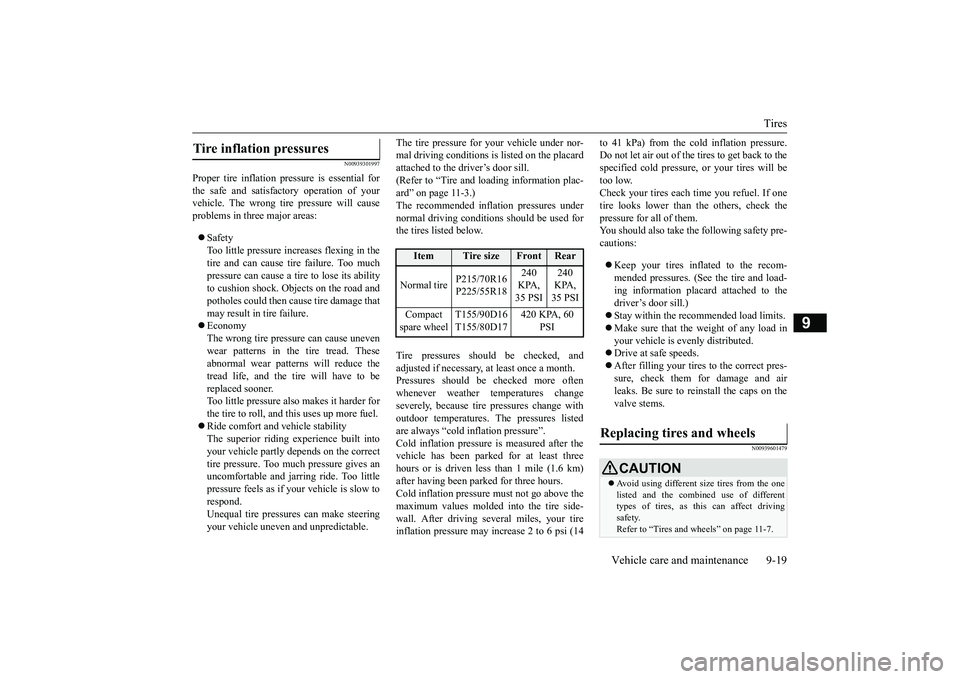
Tires
Vehicle care and maintenance 9-19
9
N00939301997
Proper tire inflation pre
ssure is essential for
the safe and satisfac
tory operation of your
vehicle. The wrong tire pressure will causeproblems in three major areas:SafetyToo little pressure increases flexing in thetire and can cause tire failure. Too muchpressure can cause a tire to lose its abilityto cushion shock. Objects on the road andpotholes could then ca
use tire damage that
may result in tire failure.EconomyThe wrong tire pressu
re can cause uneven
wear patterns in the tire tread. Theseabnormal wear patter
ns will reduce the
tread life, and the tire will have to bereplaced sooner.Too little pressure also makes it harder forthe tire to roll, and this uses up more fuel.Ride comfort and vehicle stabilityThe superior riding e
xperience built into
your vehicle partly de
pends on the correct
tire pressure. Too much pressure gives anuncomfortable and jarring ride. Too littlepressure feels as if
your vehicle is slow to
respond.Unequal tire pressure
s can make steering
your vehicle uneven
and unpredictable.
The tire pressure for your vehicle under nor-mal driving conditions is listed on the placardattached to the driver’s door sill.(Refer to “Tire and loading information plac-ard” on page 11-3.)The recommended inflation pressures undernormal driving conditions should be used forthe tires listed below.Tire pressures should be checked, andadjusted if necessary, at least once a month.Pressures should be checked more oftenwhenever weather temperatures changeseverely, becaus
e tire pressures change with
outdoor temperatures. The pressures listedare always “cold in
flation pressure”.
Cold inflation pressure is measured after thevehicle has been parked for at least threehours or is driven less than 1 mile (1.6 km)after having been parked for three hours.Cold inflation pressure must not go above themaximum values molded into the tire side-wall. After driving several miles, your tireinflation pressure may increase 2 to 6 psi (14
to 41 kPa) from the cold inflation pressure.Do not let air out of the tires to get back to thespecified cold pressure, or your tires will betoo low.Check your tires each t
ime you refuel. If one
tire looks lower than the others, check thepressure for all of them.You should also take the following safety pre-cautions:Keep your tires inflated to the recom-mended pressures. (See the tire and load-ing information placard attached to thedriver’s door sill.)Stay within the recommended load limits.Make sure that the weight of any load inyour vehicle is evenly distributed.Drive at safe speeds.After filling your tires to the correct pres-sure, check them for damage and airleaks. Be sure to reinstall the caps on thevalve stems.
N00939601479
Tire inflation pressures
Item
Tire size
Front
Rear
Normal tire
P215/70R16P225/55R18
240 KPA, 35 PSI
240 KPA, 35 PSI
Compact spare wheel
T155/90D16T155/80D17
420 KPA, 60
PSI
Replacing tires and wheels
CAUTIONAvoid using different size tires from the onelisted and the combined use of differenttypes of tires, as this can affect drivingsafety.Refer to “Tires and wheels” on page 11-7.
BK0249100US.book 19 ページ 2017年5月10日 水曜日 午前8時49分
Page 400 of 441
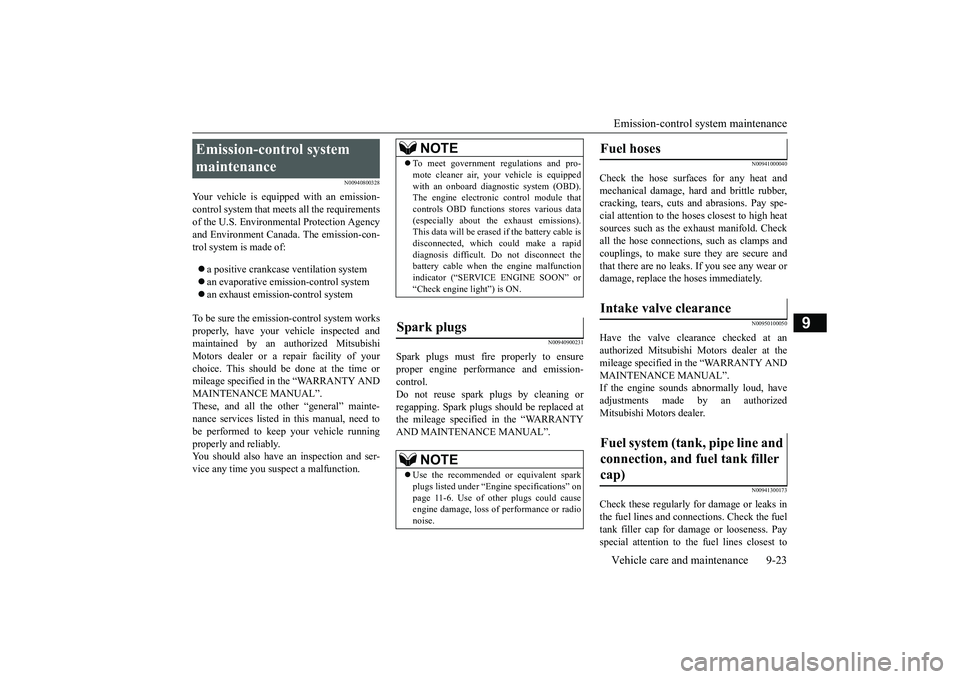
Emission-control system maintenanceVehicle care and maintenance 9-23
9
N00940800328
Your vehicle is equi
pped with an emission-
control system that meets all the requirementsof the U.S. Environm
ental Protection Agency
and Environment Cana
da. The emission-con-
trol system is made of:a positive crankcase
ventilation system
an evaporative emis
sion-control system
an exhaust emission-control system
To be sure the emissi
on-control system works
properly, have your vehicle inspected andmaintained by an authorized MitsubishiMotors dealer or a repair facility of yourchoice. This should be done at the time ormileage specified in the “WARRANTY ANDMAINTENANCE MANUAL”.These, and all the other “general” mainte-nance services listed in this manual, need tobe performed to keep
your vehicle running
properly and reliably.You should also have an inspection and ser-vice any time you suspect a malfunction.
N00940900231
Spark plugs must fire properly to ensureproper engine perfo
rmance and emission-
control.Do not reuse spark plugs by cleaning orregapping. Spark plugs should be replaced atthe mileage specified in the “WARRANTYAND MAINTENANCE MANUAL”.
Check the hose surfaces for any heat andmechanical damage, hard and brittle rubber,cracking, tears, cuts and abrasions. Pay spe-cial attention to the hos
es closest to high heat
sources such as the exhaust manifold. Checkall the hose connections
, such as clamps and
couplings, to make sure
they are secure and
that there are no leaks. If you see any wear ordamage, replace the
hoses immediately.
N00950100050
Have the valve clea
rance checked at an
authorized Mitsubishi Motors dealer at themileage specified in the “WARRANTY ANDMAINTENANCE MANUAL”.If the engine sounds abnormally loud, haveadjustments made by an authorizedMitsubishi Motors dealer.
N00941300173
Check these regularly for damage or leaks inthe fuel lines and connections. Check the fueltank filler cap for dama
ge or looseness. Pay
special attention to the fuel lines closest to
Emission-control system maintenance
NOTE
To meet government regulations and pro-mote cleaner air, your
vehicle is equipped
with an onboard dia
gnostic system (OBD).
The engine electronic control module thatcontrols OBD functions stores various data(especially a
bout the exhaust emissions).
This data will be erased if the battery cable isdisconnected, which c
ould make a rapid
diagnosis difficult.
Do not disconnect the
battery cable when the engine malfunctionindicator (“SERVICE ENGINE SOON” or“Check engine
light”) is ON.
Spark plugs
NOTE
Use the recommended or equivalent sparkplugs listed under “Engin
e specifications” on
page 11-6. Use of other plugs could causeengine damage, loss of performance or radionoise.
Fuel hoses Intake valve clearance Fuel system (tank, pipe line and connection, and fuel tank filler cap)
BK0249100US.book 23 ページ 2017年5月10日 水曜日 午前8時49分
Page 401 of 441

General maintenance9-24 Vehicle care and maintenance
9
high heat sources such
as the exhaust mani-
fold.
N00941400187
If the fuel-vapor vent line is clogged or dam-aged, the fuel-vapor mixture will escape, pol-luting the air.Have the system checked at an authorizedMitsubishi Motors dealer at the mileage spec-ified in the “WARRANTY AND MAINTE-NANCE MANUAL”.
N00941501299
The next pages list th
e maintenance service
recommended by Mitsubishi Motors Corpo-ration. In addition to the general maintenancethat needs to be performed at the times listed,
there are other parts which do not usuallyneed regular maintenance.But, if any of these parts stops working prop-erly, your vehicle performance could suffer.Have these items checked if you notice aproblem with them.If you have any questions, see your autho-rized Mitsubishi Motors
dealer for assistance.
N00941600059
Good brakes are essential for safe driving.Check the brake pads for wear. For goodbraking performance, replace the brake padswith the same type pa
ds as the originals.
N00941700076
Brake hoses and tubing should be checkedfor:Severe surface cracking, scuffing or wornspots. If the fabric casing of the hose isshowing through any cracks or worn spotsin the rubber hose cover, the hose shouldbe replaced. The brakes can fail if thehose wears through.Improper installati
on may cause twisting,
or wheel, tire or
chassis interference.
N00941800093
Check the following parts for damage andgrease leaks:Ball joint boots of the suspension andsteering linkageBellows on both ends of the drive shaft
N00942201118
The best way to keep carbon monoxide gasfrom entering inside your
vehicle is to have
the engine exhaust syst
em properly serviced.
Have a competent mechanic inspect the com-plete exhaust system
and nearby body areas
for broken, damaged, deteriorated, or mispo-sitioned parts if you no
tice any of the follow-
ing:A change in the sound of the exhaust sys-temThe smell of exhaust fumes inside thevehicle
WA R N I N GIf you see a fuel leak
or if you smell fuel,
do not run the engine. Any spark (includ-ing from the ignition
), flame or smoking
material could cause an explosion or fire.Call an authorized
Mitsubishi Motors
dealer or a repair fa
cility of your choice
for assistance.
Evaporative emission control system (except evaporative emission canister) General maintenance
Disc brake pads Brake hoses
Ball joint, steering linkage seals, drive shaft boots Exhaust system
WA R N I N GCarbon monoxide gas
from your vehicle’s
exhaust is poisonous. Breathing thesefumes can cause unconsciousness or death.
BK0249100US.book 24 ページ 2017年5月10日 水曜日 午前8時49分